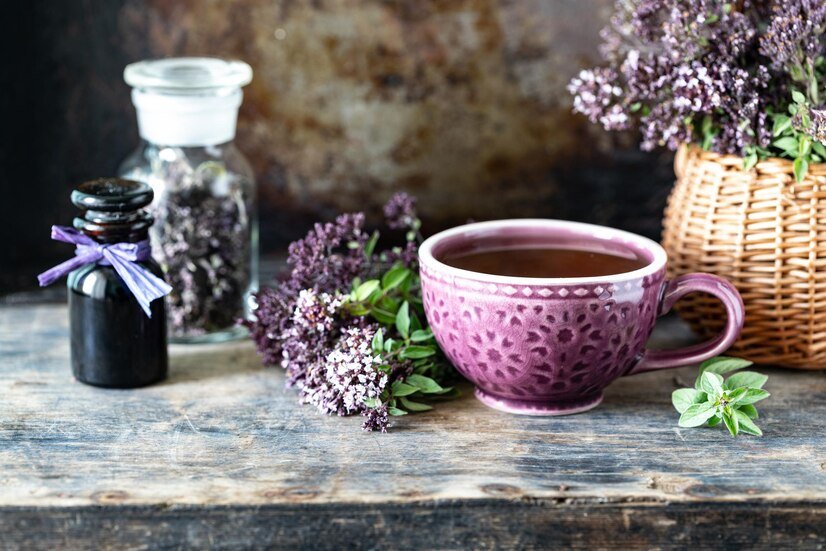FOOD
Lavender Tea: A Fragrant Brew for Wellness 3 Great
Lavender Tea Lavender tea is a delightful herbal infusion made from the fragrant buds of the lavender plant.

Lavender tea is a delightful herbal infusion made from the fragrant buds of the lavender plant. Known for its calming aroma and therapeutic properties, lavender tea has been enjoyed for centuries, dating back to ancient civilizations such as the Greeks and Romans. Today, it continues to gain popularity as a natural remedy for various health concerns and as a soothing beverage for relaxation.
Health Benefits of Lavender Tea
One of the primary reasons for the widespread popularity of lavender tea is its numerous health benefits. Firstly, it is renowned for its ability to promote relaxation and alleviate stress and anxiety. The soothing aroma of lavender can help calm the mind and induce a sense of tranquility, making it an excellent choice for unwinding after a long day.
Additionally, lavender tea is often recommended for improving sleep quality. Drinking a cup of lavender tea before bedtime can help promote a more restful night’s sleep, making it especially beneficial for individuals struggling with insomnia or other sleep disorders.
Moreover, lavender tea is known to aid digestion and soothe gastrointestinal discomfort. Its natural antispasmodic properties can help alleviate symptoms of bloating, gas, and indigestion, making it a gentle remedy for digestive issues.
Furthermore, lavender tea is rich in antioxidants, which help protect the body against oxidative stress and reduce the risk of chronic diseases. Regular consumption of lavender tea may contribute to overall health and well-being by supporting the immune system and promoting cellular health.
How to Make Lavender Tea
Making lavender tea at home is simple and requires only a few ingredients. To brew a delicious cup of lavender tea, you will need dried lavender buds or fresh lavender flowers, hot water, and optional sweeteners such as honey or sugar.
Start by boiling water and placing the dried lavender buds or fresh flowers in a teapot or infuser. Pour the hot water over the lavender and allow it to steep for about 5-10 minutes, depending on your desired strength. Strain the tea and sweeten to taste, if desired.
For an extra burst of flavor, consider adding a slice of lemon or a sprig of mint to your lavender tea. Experiment with different brewing methods and proportions to find the perfect balance of aroma and taste.
Lavender Tea Varieties
When it comes to lavender tea, there are several varieties to choose from, each offering its own unique flavor profile and aroma. Culinary lavender, also known as Lavandula angustifolia, is commonly used for tea and culinary purposes due to its sweet and floral fragrance. English lavender, on the other hand, has a slightly more robust flavor and is often used in herbal remedies and aromatherapy.
In addition to pure lavender tea, you can also find a variety of blends and infusions that combine lavender with other herbs and botanicals for added flavor and benefits. Some popular lavender tea blends include lavender chamomile tea, lavender earl grey tea, and lavender mint tea.
Potential Side Effects and Precautions
While lavender tea is generally considered safe for most people when consumed in moderation, it’s essential to be aware of potential side effects and precautions. Some individuals may experience allergic reactions or skin sensitivities to lavender, especially if they have a history of allergies to plants in the Lamiaceae family, such as mint or sage.
Furthermore, lavender tea may interact with certain medications, including sedatives, antidepressants, and blood pressure medications. If you are taking any prescription medications, it’s advisable to consult with your healthcare provider before incorporating lavender tea into your routine to avoid any potential adverse effects.
Additionally, pregnant and breastfeeding women should exercise caution when consuming lavender tea, as its safety during pregnancy and lactation has not been conclusively established. It’s best to err on the side of caution and consult with a healthcare professional before drinking lavender tea while pregnant or breastfeeding.
Lavender Tea Recipes
In addition to enjoying lavender tea on its own, you can also get creative with recipes that incorporate this fragrant herb into various beverages and dishes. For example, lavender chamomile tea combines the calming properties of both herbs for a soothing bedtime drink.
For a refreshing twist, try making lavender lemonade by adding a few drops of lavender syrup to freshly squeezed lemon juice and water. Garnish with lavender sprigs for an elegant touch.
During the summer months, lavender iced tea makes a delightful and refreshing beverage. Simply brew lavender tea as usual, then chill it in the refrigerator until cold. Serve over ice with a splash of honey or lemon for a cooling and aromatic drink.
Using Lavender Tea in Skincare
Beyond its culinary and therapeutic uses, lavender tea is also prized for its skincare benefits. The anti-inflammatory properties of lavender make it an excellent ingredient for soothing irritated or inflamed skin.
You can create your own DIY lavender tea toner by brewing a strong batch of lavender tea, allowing it to cool, and then transferring it to a spray bottle. Spritz onto clean skin as a refreshing toner or use it to calm redness and inflammation after shaving or sun exposure.
Moreover, lavender tea can be used to alleviate symptoms of various skin conditions, including acne, eczema, and psoriasis. Its gentle yet effective properties make it suitable for all skin types, including sensitive skin.
Lavender Tea for Mental Health
In addition to its physical health benefits, lavender tea is also valued for its positive effects on mental health and well-being. The soothing aroma of lavender has long been used in aromatherapy to promote relaxation and reduce feelings of anxiety and stress.
Incorporating lavender tea into your daily self-care routine can help create moments of calm and tranquility amidst the hustle and bustle of modern life. Whether enjoyed as part of a mindfulness practice or simply as a comforting ritual, lavender tea can provide a much-needed respite from the stresses of everyday life.
Cultural Significance of Lavender
Throughout history, lavender has held cultural significance in various civilizations around the world. In ancient times, it was prized for its medicinal properties and used in religious ceremonies and rituals.
In European folklore, lavender was believed to ward off evil spirits and bring good luck and prosperity. It was often used to make protective amulets and sachets that were worn or placed in the home to promote health and happiness.
Today, lavender continues to be associated with purity, love, and tranquility, making it a popular choice for weddings, celebrations, and rituals honoring the natural world.
Lavender Tea in Modern Wellness Trends
In recent years, lavender tea has experienced a resurgence in popularity as part of the broader wellness movement. With an increasing emphasis on holistic health and natural remedies, lavender tea has become a staple in many wellness routines.
From yoga studios to spa retreats, lavender tea is often featured as a calming beverage that complements relaxation and mindfulness practices. Its gentle yet effective properties make it an accessible option for those seeking natural ways to support their physical and mental well-being.
Moreover, commercial brands have capitalized on the popularity of lavender tea by offering a wide range of products, including teas, essential oils, bath and body products, and culinary ingredients. Whether enjoyed as a soothing beverage or incorporated into skincare and aromatherapy rituals, lavender tea continues to be embraced by wellness enthusiasts worldwide.
Growing Lavender for Tea
For those interested in cultivating their own lavender for tea, it’s essential to choose the right variety and provide the ideal growing conditions. Lavender thrives in sunny, well-drained soil and prefers a Mediterranean climate with mild winters and hot, dry summers.
When planting lavender, be sure to space the plants adequately to allow for proper air circulation and prevent overcrowding. Prune the plants regularly to encourage bushy growth and remove spent flowers to promote continuous blooming throughout the growing season.

Harvest lavender flowers when they are fully open but before they begin to fade. Cut the stems just above the foliage and hang them upside down in a warm, dry place to dry. Once dried, the lavender flowers can be stored in airtight containers and used to make tea, sachets, or other herbal remedies.
Conclusion
lavender tea offers a fragrant and flavorful brew that not only delights the senses but also provides a myriad of health benefits. From promoting relaxation and improving sleep quality to soothing digestive discomfort and supporting mental well-being, lavender tea is a versatile herbal infusion with something to offer everyone. Whether enjoyed on its own or incorporated into skincare and culinary creations, lavender tea is a delightful addition to any wellness routine.
FAQs
How much lavender tea should I drink daily?
The recommended dosage of lavender tea varies depending on individual tolerance and health conditions. It’s generally advisable to start with a small amount and gradually increase as needed. Consult with a healthcare professional for personalized recommendations.
Can children consume lavender tea?
While lavender tea is considered safe for most adults, it’s best to avoid giving it to young children, as their bodies may be more sensitive to the effects of herbs. Consult with a pediatrician before giving lavender tea to children.
Is lavender tea safe during pregnancy?
Pregnant women should exercise caution when consuming lavender tea, as its safety during pregnancy has not been thoroughly studied. It’s advisable to consult with a healthcare provider before drinking lavender tea while pregnant.
Where can I buy high-quality lavender tea?
High-quality lavender tea can be purchased from specialty tea shops, health food stores, and online retailers. Look for organic, loose-leaf lavender tea for the best flavor and aroma.
Can lavender tea help with migraines?
Some people find relief from migraines and tension headaches by drinking lavender tea or inhaling its aroma. However, more research is needed to determine the effectiveness of lavender tea for migraine relief. As always, consult with a healthcare professional for personalized treatment options.
Table of Contents
-

 Tech1 year ago
Tech1 year agoHow to Use a Temporary Number for WhatsApp
-

 Business2 years ago
Business2 years agoSepatuindonesia.com | Best Online Store in Indonesia
-

 Social Media1 year ago
Social Media1 year agoThe Best Methods to Download TikTok Videos Using SnapTik
-

 Technology1 year ago
Technology1 year agoTop High Paying Affiliate Programs
-

 Tech10 months ago
Tech10 months agoUnderstanding thejavasea.me Leaks Aio-TLP: A Comprehensive Guide
-

 FOOD12 months ago
FOOD12 months agoHow to Identify Pure Desi Ghee? Ultimate Guidelines for Purchasing Authentic Ghee Online
-

 Instagram3 years ago
Instagram3 years agoFree Instagram Auto Follower Without Login
-

 Instagram3 years ago
Instagram3 years agoFree Instagram Follower Without Login




















